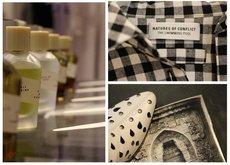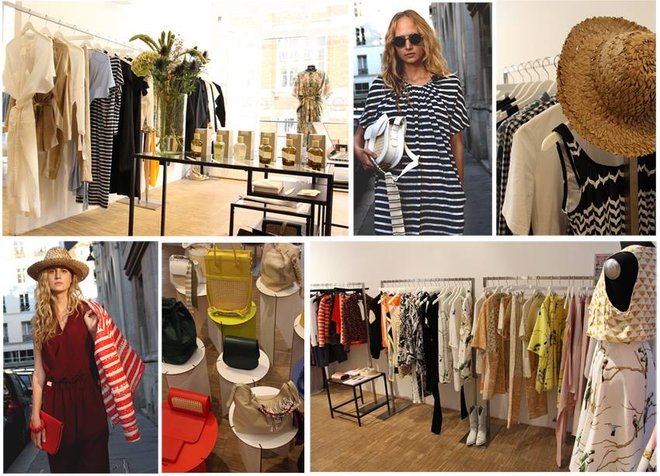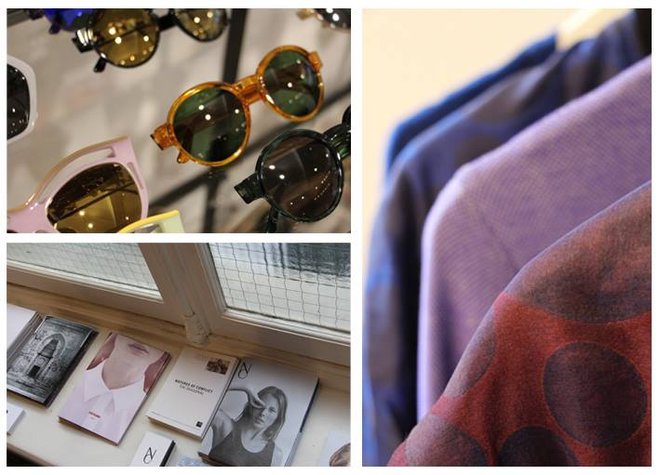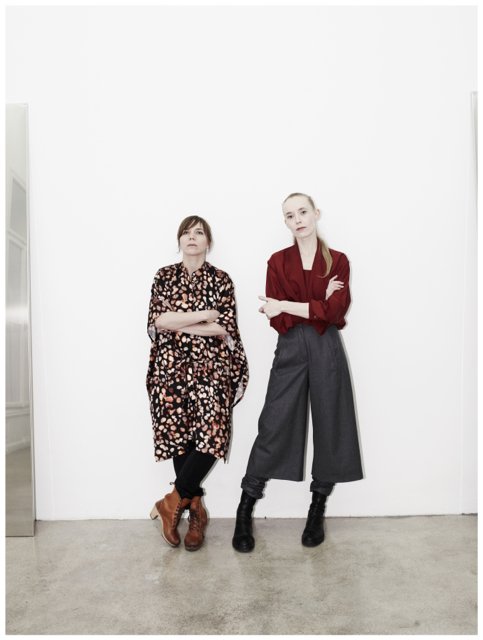Design Made In Austria
Vienna, Lindengasse. In the heart of the 7th district, between boho cafés, hipster shops, and trendy hairdressers, Camille Boyer and Marlene Agreiter have been running the AFA – Austrian Fashion Association, the official support agency for contemporary Austrian fashion design, for almost two years.
Creative chaos prevails in the office. Meter-high banners advertising the recent Austrian Fashion Awards 2015 lean in the corners. Clothes rails, boxes, and outfits have yet to make it to the storage room. “There’s a lot to do,” say the two trained fashion designers. What precisely, they tell in the interview.
Stephanie Rugel: Je suis tellement curieux. How was it in Paris? The AFA Showroom just took place there for the second time! You took along collections from Austrian newcomers such as DMMJK but also from established labels like Ute Ploier or WienerBlut.
Camille Boyer: Je suis très satisfait. (laughs) Things went even better than last year. I’d say the showroom is becoming more and more established. Especially the high quality of the Austrian collections is greatly appreciated, from the manufacturing down to the materials.
Sounds optimistic. But can Austrian fashion design really be a serious player in Paris?
Marlene Agreiter: Totally. Last year there were buyers from international stores like Dover Street Market in London, Opening Ceremony in New York, Antonioli in Milan or Galeries Lafayette in Paris. Colette Paris ordered perfume by WienerBlut. Robert Rabensteiner even passed by (editor of L’Uomo Vogue, stylist, consultant for brands like Cavalli, Moncler, Trussardi – editor’s note). This year there was a representative from the internationally acclaimed Hyères Fashion and Photography Festival, along with buyers from Hong Kong and China. The audience was generally even more international than last year.
Was there a particularly special moment for you in Paris?
C.B.: The moment when you notice that you can reach a whole lot of people with social media. (laughs) We posted photos of the AFA Showroom on Instagram and Facebook, and soon thereafter there were actually clients who referred to it. It was the first time we experienced this so directly – and it’s fascinating.
"Dear fashion designers, get qualified feedback on your collections, over and over again!"
What are the criteria for your selection of labels for Paris?
C.B.: We already made collective showrooms in Berlin and Paris before AFA, so we have experience. This showroom was organized together with Britta Song, who has been working in the sales sector for showrooms of famous designers such as Raf Simons, Margiela, Yamamoto, and so on since 20 years. Moreover, we also work with two other experts in the sales segment: Muriel Piaser from Paris and Myriam Vanheusden from Belgium. We chose this year’s participants together with them.
Who has chances of making the best-of list for Paris?
C.B.: The labels need to have been active for several seasons, work very professionally, deliver by the deadlines, and follow time schedules. The portfolio needs to be consistent in terms of quality, standard, and price. We also compile a portfolio of buyers, so the labels need to fit stylistically as well. Not only the presentation of fashion is important; there are also lifestyle products like the perfumes this year by WienerBlut, the sunglasses by Andy Wolf Eyewear, and the bags by Bradaric Ohmae.
"The buyers just observe at first; they need continuity."
Are sales also made in Paris or is it more of an image event?
C.B.: In terms of attendance the showroom worked very well. Orders were placed, but there is still room for improvement. It is customary in this trade that it takes a couple of seasons because many of the designers we present are “new”. That means that some of them were never in Paris or only presented their collection there one time tops. The buyers just observe at first; they need continuity in order to be sure that the designer can deliver a solid product and guarantee quality. The Viennese fashion design duo Femme Maison, for example, currently has their own space in Galeries Lafayette in Paris for a month – in the same section where big labels like Azzedine Alaya or Lanvin are presented. That is also a success for our showroom.
Paris isn’t a walk in the garden! Do you provide a sort “Fashion Survival Kit”
C.B.: We hold showroom coachings with designers in order to ensure that their pricing is realistic and that contact is made with the appropriate buyers for them – because THE “Fashion Start-Up Survival Kit” doesn’t exist. Success in fashion depends on countless factors. Our task is to recognize potential and support it. So here’s my advice: Dear fashion designers, get qualified feedback on your collections, over and over again!
How is the showroom financed?
M.A.: The Austrian Fashion Association pays a big part from the subsidies of the Federal Chancellery and the City of Vienna. We also have a cooperation with the Austrian Trade Agency. And a small fee is left up to the participants.
Every now and then you hear from people who are not rooted in the fashion scene that they’re not exactly sure what the Austrian Fashion Association does. Any idea why that is?
C.B.: The projects we do rarely generate big headlines, rather they are
more often of an internal and structural nature. So they are often not
perceived outside of the scene. Our aim is to be there for the needs of
designers, but we do not promote ourselves as the AFA.
M. A.: On the one hand, we are mediators between the funding bodies and
the designers. In this context we act as partners for the distribution
of funds. On the other hand, it is about making better connections
between the fashion scene and the economy. On top of that, we do press
work and work intensively on our international network.
Is distinguishing yourself from the AFA predecessor Unit F – büro für mode, the team around Ulrike Tschabitzer-Handler and Andreas Oberkanis, still an issue?
C.B.: In the beginning it was an enormous challenge, practically
starting from zero. The expectations are still very high. We are doing
our best – but we’re pursuing a different track, have different focuses,
we’re different people, and accordingly have different approaches. And
that’s why the Austrian Fashion Awards are also positioned differently.
M.A.: 13 years Unit F also means 13 years more experience. When you
start anew you are perhaps too blue-eyed and too idealistic sometimes,
maybe sometimes you want too much and underestimate processes and
timeframes. Naturally, we orient ourselves upon role models such as the Flanders Fashion Institute (FFI), Wallonie Bruxelles Design Mode (wbdm), the Danish Fashion Institute (DAFI), and the paramount example British Fashion Council (BFC), but also upon Unit F oder dem austrianfashion.net. We have distilled a good essence for us from all of them.
Camille, you are French by birth. What brought you to Vienna?
C.M.: Love! But that stays between us. (laughs)
"Naturally, we orient ourselves upon role models."
How sweet! We don’t want to keep that from our readers. (laughs) How did you establish your professional life in Vienna?
C. B.: I studied fashion in Paris, and I worked for the Austrian fashion platform Unit F. After that I lived in China for two years and led the fashion departments for different companies and taught at the university. Back in Austria I opened a shop under my own name with international as well as young Austrian fashion design. Parallel I had jobs with different fashion institutions like austrianfashion.net and helped Austrian designers, such as Sonja Bischur and Florian Ladstätter, with their presentations in Paris. Then one day I met Marlene at the Kooperationsbörse Mode. As we instantly found each other sympathetic, I asked her if she was interested in organizing a shared showroom in Paris. That was the kick-off for our collaboration.
Marlene, how did you come to fashion?
M.A.: After my studies in psychology I did a mini-job in the social sector, then came my creative awakening. (laughs) In the next semester I started my fashion design studies under Raf Simons, although I never completed them.
What happened?
M. A.: In the second year – Veronique Branquinho took over as chair – I asked myself what I wanted to do exactly in the fashion world. Then I decided to pursue an education in cultural management. Once I completed it I worked on many small projects. And then came the point that you could call the founding moment of the AFA. In 2013 there was a tender from the BMUKK (The Austrian Federal Ministry of Education, Arts and Culture – editor’s note), as it was called at the time, and the City of Vienna, looking for a successor for Unit F. We applied, and it actually worked out in the end. For the first time we had an annual budget, which facilitated longer term planning.
"Fashion can be very exploitative."
Now you have nearly two years AFA behind you. Already success stories in the books?
M.A.: Many. For example, we realized a project for Expo Mailand in the framework of a cooperation with the expoaustria office of the Austrian Economic Chamber in which all of the threads came together: An Austrian fashion designer, Peter Holzinger from superated, designed the corporate wear for the Expo. This illustrated just how valuable the work of creatives is – in the sense of a mediator-innovator function – in a relatively traditional economic system like the textile industry. The project had a far-reaching impact because Austria didn’t present itself in traditional lederhosen and dirndl costumes but in contemporary design. That was great!
What effect can fashion have?
C.B.: Fashion can be very exploitative, fashion can be very hierarchical, the one who stands on the lowest step can lose. Many Austrian labels, however, approach their work in an exemplary manner; they verify the production processes and origin of the materials very thoroughly. I really believe that fashion, creative work, fair production conditions, and support for small design labels can effect a change in social thinking.
Participants in the AFA Showroom: Ajla Ayidan; Bradaric Ohmae, DMMJK, Femme Maison, Natures of Conflict, Rani Bageria, CONSUMED x Thomas Zeitlberger, Ute Ploier, WienerBlut, Andy Wolf Eyewear









